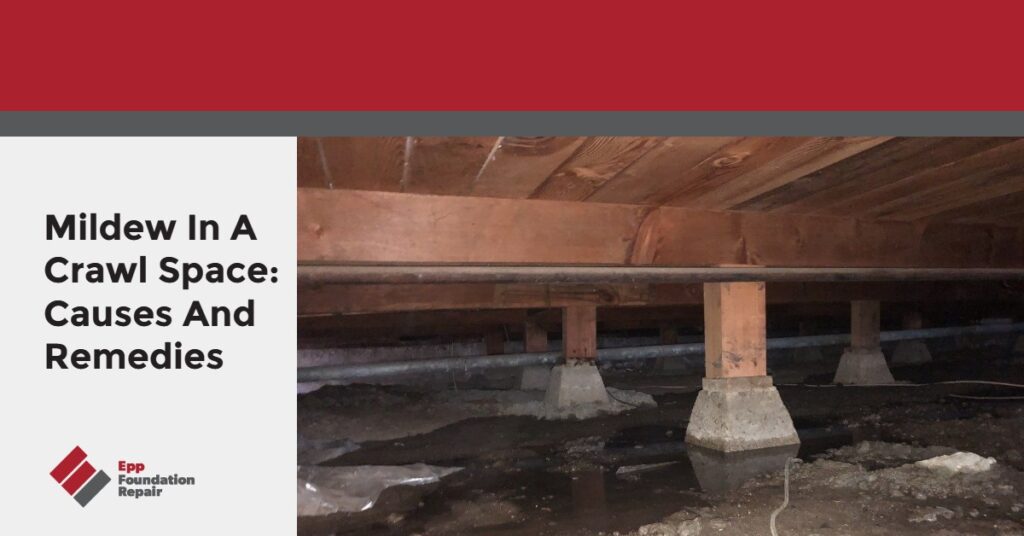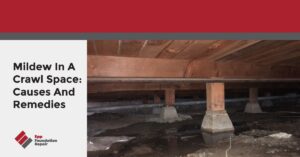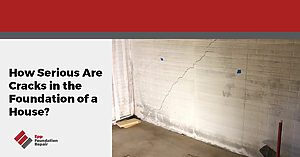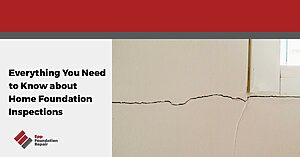Mildew in a crawl space is pretty common. However, that doesn’t mean you should consider it normal and ignore it. Mildew in a crawl space can harm both your health and the structural integrity of your home’s foundation. Therefore, you want to do everything you can to get rid of it and then prevent it from coming back. The crawl space under your home should be dry and mold-free.
This article will cover what causes mildew in a crawl space, signs of mildew in a crawl space, how to get rid of crawl space mold, and more.
First of All, What Is Mildew?
Mildew is just a type of mold. Therefore, the title of this article could be ‘’Mold in a Crawl Space’’ and it would contain the same information. In this article, we use the words ‘’mildew’’ and ‘’mold’’ interchangeably.
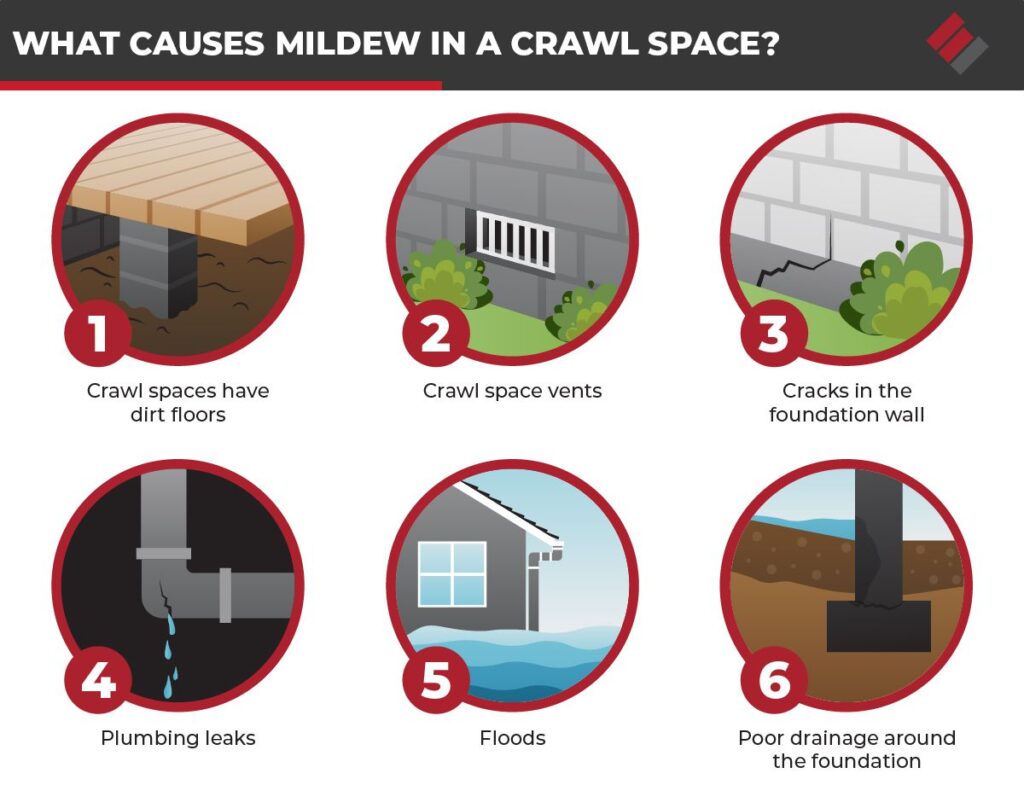
What Causes Crawl Space Mildew?
Crawl space mildew can form for various reasons, including:
- Crawl spaces have dirt floors – If there’s excess moisture in the soil under and around the foundation, the humidity level in the crawl space will rise because the dirt in the crawl space will be wet. Good drainage is essential in keeping a crawl space dry. We’ll talk more about this in just a bit.
- Crawl space vents – Open crawl space vents allow warm, humid air to enter and condense on cooler surfaces. This will cause mildew to form on structures in the crawl space, including wooden beams and joists.
- Cracks in the foundation wall – If the foundation wall is cracked, water can seep in. You might not even see these cracks. However, hydrostatic pressure caused by the build-up of water in the soil around the foundation is strong enough to push water through them and into the crawl space. For more information about hydrostatic pressure and foundation wall cracks, see Is Hydrostatic Pressure The Reason You Have a Wet Basement?
- Plumbing leaks – In addition to the moisture being released into the crawl space, a plumbing leak could also cause any insulation in the crawl space to get wet.
- Floods – This one needs no explanation.
- Poor drainage around the foundation – Poor drainage around a foundation can cause a lot of trouble, including mildew in the crawl space.
How Do I Know if I Have Mildew in My Crawl Space?
Common signs you might have mold in your crawl space include:
- There’s a musty smell in your home – Some of the air from the crawl space flows up and into your home’s living area via the stack effect (see the below graphic). If there’s mold in the crawl space, the air in your home will be full of mold spores.
- Your wooden floors are warped and/or moldy – Mildew on the wooden crawl space structures can migrate to the wooden floors and baseboards on top of the crawl space. The excess moisture can also cause the wood to warp.
- Your baseboards have mold on them – See above.
- People living in the home are experiencing allergies or respiratory problems – Inhaling mold spores can cause various health issues.
- You have a problem with pests, including insects, rodents, and termites – Damp, dark spaces attract pests.
- There are water stains on structures in the crawl space – We don’t recommend you enter the crawl space and crawl around. However, you can use a powerful flashlight from the crawl space entrance to look around a bit.
- There’s visible mold on structures in the crawl space – Do you see any mold on the beams and joists?
- You can see wood rot on the crawl space’s wooden structures – If wood rot isn’t stopped, it could eventually weaken your home’s structural integrity.
Don’t get too hung up on the type of mold in your crawl space. All mold in a crawl space is bad, and you need to get rid of it. After that, you can take steps that will prevent it from returning.
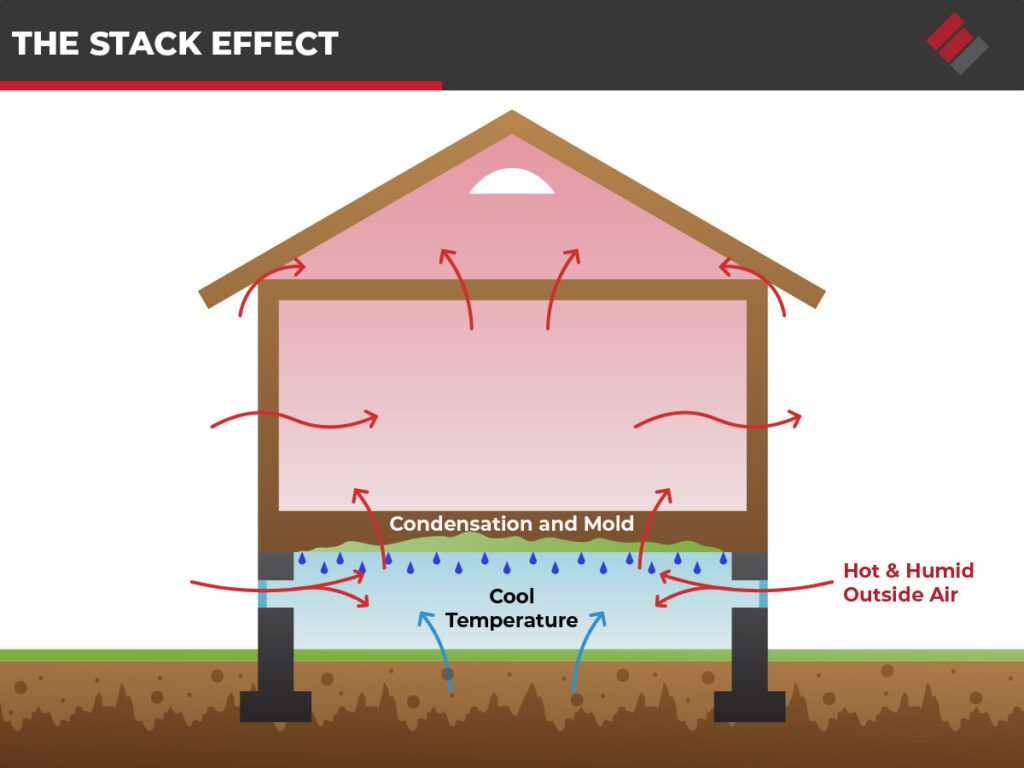
Mold, Your Health, and Your Home’s Structural Integrity
As mentioned above, a certain percentage of air in your home’s crawl space flows up and into your home’s living area due to the stack effect. If this air is full of mildew spores, it could cause problems for anyone living in the home, including allergic reactions and respiratory issues. Mold can also trigger skin problems, itchy eyes, and rashes.
Mildew in a crawl space can also encourage wood rot which could eventually threaten your home’s structural integrity.
How to Get Rid of Crawl Space Mold?
Although many homeowners think this is a DIY project, we recommend contacting a mold remediation specialist instead of trying to get rid of crawl space mold by yourself. Your home’s crawl space is full of nasty things like pests (spiders, rate, snakes), dangerous rodent droppings, sharp things, etc. Never enter your home’s crawl space without protective gear, including a respirator.
We also recommend letting a mold remediation specialist handle the job simply because they have experience getting rid of mildew in a crawl space. They know what it looks like, where to find it, and how to make sure it’s gone. If you DIY, you might spend a lot of time and effort only to find out later that you missed a spot or two.
After the mildew in your crawl space has been eradicated, you’ll need to ensure it doesn’t return.
How To Prevent Mildew in a Crawl Space?
Once you’ve gotten rid of the mildew in your crawl space, you’ll need to ensure it doesn’t come back. You can do that by making sure the crawl space stays dry. The only way to do that is to get the groundwater around the foundation under control. If you’re trying to keep your crawl space dry, you don’t want excess water in the soil around the foundation.
How to Make Sure Excess Water Can’t Build Up in the Soil Around the Foundation
The best way – by far – to ensure the soil around the foundation stays dry is to install a drain tile system. There simply is no better way to control groundwater around your foundation. For more information on drain tile systems, see How Does A Drain Tile System Work?
Other things you can do include:
- Crawl space encapsulation and a dehumidifier – After installing a drain tile system, many homeowners have their crawl space encapsulated. Encapsulation involves covering the floor and walls of the crawl space with a thick vapor barrier. For more information, see Is Crawl Space Encapsulation Worth It? Yes!
- Make sure you don’t have any leaking pipes.
- Insulate your pipes so condensation can’t form on them.
- Make sure your dryer vent isn’t blowing air into the crawl space.
- Check your foundation wall for cracks. If you find any, call a foundation repair contractor and have them fixed.
- Regrade your yard, if necessary – The yard around your home should slope away from the foundation. This prevents water from draining toward the foundation. A landscaping professional can help you with this, or you could DIY.
- Clean your gutters regularly – If the gutters are full of leaves and other debris, water could spill over the side of your home and soak into the soil around the foundation.
- If your downspouts are too short, install extensions – You don’t want your downspouts releasing water next to the foundation. Extensions are easy to install and will carry water away from the foundation before releasing it.
- Install an underground downspout with a pop-up emitter – Water from the gutters flows into the underground downspout and gets channeled toward a pop-up emitter situated around 10 feet from your foundation. When it fills with water, it pops up and releases the water away from the foundation. (When the pop-up emitter is empty, it’s virtually invisible on your lawn.)
If you’re having trouble with mildew in a crawl space and are in our service area in Nebraska, Iowa, Kansas, and Missouri, contact us today for an inspection and estimate.

